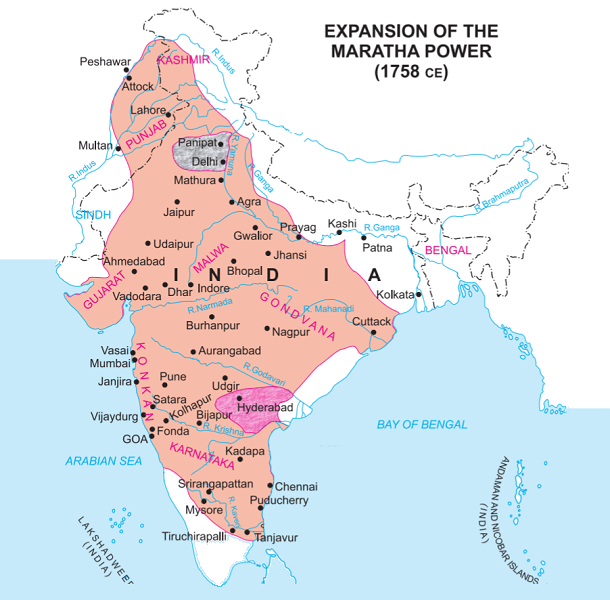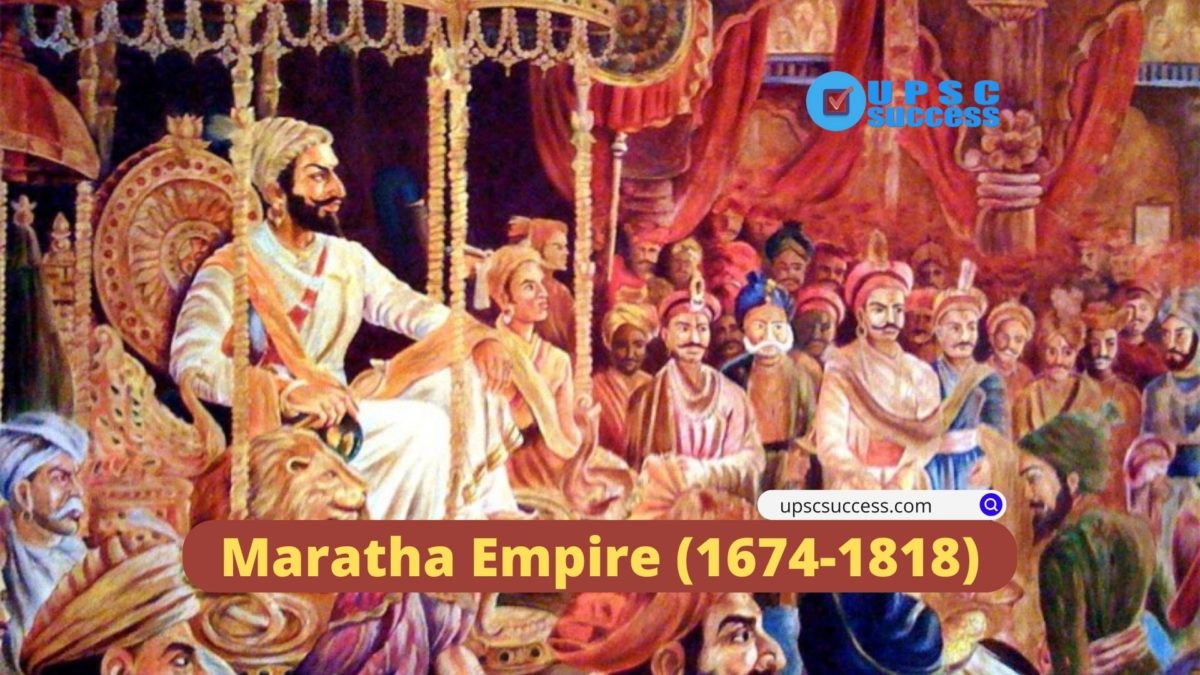Contents
- 1 Maloji Raje Bhonsle
- 2 Shahaji Raje Bhonsle (1674-80)
- 3 Sambhaji (1681–89)
- 4 Rajaram (1689-1707)
- 5 Shahu (1707-49)
- 6 Rajaram II (1749–77)
- 7 Royal House of Kolhapur
- 8 Office of the Peshwa (1640–1818)
- 8.1 Sonopant Dabir (1640–52)
- 8.2 Moropant Trimbak Pingle (1674-1683)
- 8.3 Nilakanth Moreshvar Pingale (1683-1689)
- 8.4 Ramchandra Pant Amatya (1689–1708)
- 8.5 Bahiroji Pingale (1708-1711)
- 8.6 Parshuram Trimbak Kulkarni (1711-1713)
- 8.7 Balaji Vishwanath (1713–19)
- 8.8 Peshwa Bajirao I (1720–40)
- 8.9 Balaji Baji Rao I/ Nana Sahib I (1740–61)
- 8.10 Madhav Rao (1761–72)
- 8.11 Sawai Madhav Rao (1774–95)
- 8.12 Baji Rao II (1796–1818)
- 9 Maratha Empire Administration
- 10 The decline of the Maratha Empire
The Maratha Empire dominated a large part of the Indian subcontinent in the 17th century.
The empire formally existed from 1674 with the coronation of Chattrapati Shivaji Maharaj and ended in 1818 with the defeat of Peshwa Bajirao II at the hands of the British East India Company.
Maloji Raje Bhonsle
- He joined Nizam Shah with a small band of cavalry.
Shahaji Raje Bhonsle (1674-80)
The Maratha Empire started with Shahaji Raje Bhonsle.
Served under Nizam Shah and Adil Shah, and came to prominence as a leading Maratha.
After the fall of Ahmadnagar, he transferred his services to Bijapur.
Sambhaji (1681–89)
Sambhaji was defeated by the Mughal commander Muqqarrab Khan and was killed along with his personal counsellor, Kavi Kalash.
Rajaram (1689-1707)
The younger brother of Sambhaji, who never sat on the throne, as he claimed that he was ruling on behalf of Shahu.
Shifted his headquarters to Ginjee.
After the Mughals conquered Ginjee, he fled to Vishalgarh and then to Satara, giving Hukumat Panha (King status) to Peshwa Ramchandra Pant.
After his death in 1700, his widow Tarabai assumed control in the name of her infant son Shivaji II.
Shahu (1707-49)
Shahu was released by Zulfiqar Khan (Bahadur Shah) hoping for a civil war among Marathas.
In 1707 with the help of a Chitpavan Brahman named Balaji Vishwanath, Shahu was successful in defeating Tarabai at the Battle of Khed.
Tarabai went away to Kolhapur, establishing the Royal House of Kolhapur.
In 1719, Shahu, under the advice of Peshwa Balaji Vishwanath, assisted the Saiyyad brothers in the execution of Farukkh Siyar and got his mother released.
Soon after he declared Swaraja the Independence of Maratha land.
Rajaram II (1749–77)
Rajaram II was the adopted son of Shahu
Peshwa Baji Rao retained him as the titular Chattrapati.
The power of the Chhatrapati was almost totally overshadowed by that of the Peshwa.
Royal House of Kolhapur
Shivaji II (1710–14)
Son of Queen Tarabai and Rajaram, and was under the regency of Queen Tarabai.
Sambhaji II (1714–60)
- Son of Rajaram from his second wife Rajabai, who deposed Shivaji II and Tarabai by the palace revolution in 1714.
- He signed the Treaty of Warna in 1731 with his cousin Shahu to formalize the two separate seats of the Bhonsle family.
- British sent expeditions against Kolhapur in 1765 and 1792.
- State entered into a treaty with the British after the collapse of the Maratha confederacy in 1812.

Office of the Peshwa (1640–1818)
The word ‘Peshwa’ probably originated in Persian, meaning ‘foremost’, and was introduced in Deccan by the Muslim rulers.
The duties of a Peshwa were equal to that of a Prime Minister.
Sonopant Dabir (1640–52)
- First unofficial Peshwa
Moropant Trimbak Pingle (1674-1683)
- Participated in the battles at Trimbakeshwar Fort and Wāni-Dindori against the Mughal Empire.
- Moropant introduced sound revenue administration to Shivaji’s regime and played an important role in resource planning concerning defences and maintenance of strategic forts.
- He was also responsible for the construction and administration of Pratapgad.
Nilakanth Moreshvar Pingale (1683-1689)
- Nilakanth Moreshvar Pingale was the second Peshwa of the Maratha Empire.
- In 1689, he was killed together with the Maratha King Sambhaji.
Ramchandra Pant Amatya (1689–1708)
- Peshwa under Rajaram.
- Rajaram had to escape to Ginjee in 1689, he gave Hukumat Panha (King status) to Pant before leaving.
- He wrote Adnyapatra.
Bahiroji Pingale (1708-1711)
Parshuram Trimbak Kulkarni (1711-1713)
Balaji Vishwanath (1713–19)
- Balaji Vishwanath belonged to the Bhatt family of Shri Vardhan in the Konkan region.
- He made the post of the Peshwa hereditary.
- He helped Shahu become the Maratha empire ruler by seeking the support of all Maratha leaders for Shahu.
- Shahu conferred the title of Sena-karte (organizer of forces) to him.
- In 1719, he got certain rights from the Farrukh Siyar, including recognition of Shahu as the Maratha empire king.
- He got permission to collect chauth and sardeshmukhi from the six provinces of the Deccan.
- Nana Sahib belonged to this family.
Peshwa Bajirao I (1720–40)
- The Eldest Son of Balaji Vishwanath succeeded him as Peshwa at the young age of twenty.
- Baji Rao I was the most famous of all nine Peshwas and also known as “Thorale”, meaning ‘Elder’ Baji Rao.
- He was the greatest exponent of guerrilla tactics after Shivaji.
- During his lifetime, he never lost a battle and the Maratha empire reached its zenith under him.
- Baji Rao I preached and popularized the idea of Hindu Pad Padshahi.
- He defeated the Nizam on both occasions when they fought at Palkhed and Bhopal.
- In 1722, he captured Salsette and Bassein from the Portuguese.
- He shifted the administrative capital from Satara to Pune in 1728.
- He initiated the system of the confederacy among the Maratha chiefs.
- They were the Gaekwads at Baroda, the Bhonsles at Nagpur, the Holkars at Indore, the Scindias at Gwalior, and the Peshwas at Poona.
Balaji Baji Rao I/ Nana Sahib I (1740–61)
- Balaji Baji Rao succeeded his father as Peshwa at the young age of nineteen and was appointed as Peshwa by Shahuji.
- It was during his reign that the Maratha empire king Shahu died in 1749 without an issue.
- His nominated successor, Ramraja, was imprisoned by the Peshwa Balaji Baji Rao at Satara.
- The supreme power of the Maratha empire was passed into the hands of Peshwa by the Sangola Agreement in 1750.
- He defeated Bengal Nawab Alivardi Khan and one-third of the Indian sub-continent was under the Maratha empire.
- According to an agreement in 1752, the Peshwa gave protection to Mughal Emperor from internal and external enemies.
- Maratha got chauth of the northwest provinces and total revenue of the Agra and Ajmer provinces as per the agreement.
- Honouring this agreement, Marathas fought the 3rd Battle of Panipat in 1761 when Ahmad Shah Abdali invaded India.
- The defeat of Panipat checked the expansion of the Maratha empire and fragmented it.
Madhav Rao (1761–72)
- Madhav Rao defeated the Nizam and compelled Haidar Ali of Mysore to pay tribute.
- He reasserted control over northern India by defeating the Rohillas and subjugating the Rajput state and Jat chiefs.
- In 1772, he brought back Emperor Shah Alam to Delhi.
- Maratha’s empire got weakened and divided into semi-independent states.
- The most important were the Gaikwads (Gaekwars), the Holkars, and the Scindias.
Sawai Madhav Rao (1774–95)
- Son of Narayan Rao, who was merely 40 days old when crowned as Peshwa.
- The empire was managed by Nana Phadnavis, an able administrator and warrior.
- There were twelve member regency councils called the Barbhai Council.
- Out of frustration, Raghunath Rao went to the British for help which resulted in the First Anglo–Maratha war in 1775–82.
- At the battle of Talegaon in 1776, Nana Phadnavis defeated the British.
- The treaty of Purandhar in 1776 and the treaty of Salbai in 1782 were signed.
- After the death of Nana Phadnavis in 1800 the Maratha empire could not sustain itself against the British.
Baji Rao II (1796–1818)
- Son of Raghunath Rao.
- Baji Rao II signed the humiliating Treaty of Bassein with the British in 1802.
- He was defeated by the East India Company in the Third Anglo– Maratha War in 1818.
- After this, the Peshwa’s territory was annexed to the British Bombay province, and he was pensioned off.
- Nana Sahib ( Dhondu Pant ) was the adopted son of Baji Rao II.
Maratha Empire Administration
- King was assisted by a council of ministers called the Ashtapradhan
- Provinces were known as Prants.
- Prants divided into Tarfs Parganas.
- Mauzas or villages were the lowest unit.
- There were two divisions in the Maratha cavalry:
- Bargirs: Equipped and paid by the state
- Silahdars: Maintained by the nobles.
- Mavli foot soldiers played an important role in the infantry.
- Shivaji strongly discouraged revenue farming.
- Marathas employed a special script known as the ‘Modi script’ in the documents of the revenue and administrative records.
- Chauth and sardeshmukhi were two major sources of revenue
- Chauth: One-fourth (1/4th of the land revenue) was paid to the Marathas in order to avoid the Maratha raids.
- Sardeshmukhi 1/10 of land revenue on those lands on which the Marathas claimed hereditary rights.
The decline of the Maratha Empire
Madhavrao Peshwas was made a pensioner of the British and exiled to Bithoor, Uttar Pradesh. The Maratha kingdoms of Nagpur, Indore and Gwalior all slipped into the administrative powers of the British. They all became princely states and all the Maratha powers had no other chance to succeed so they surrendered to the British. This gave rise to the Treaty of Gwalior (5th November 1817).
The Treaty of Mandeswar was signed by Holkar on 6th January 1818 and it required the Holkar state to remain as a subsidiary of the British.
The British East India Company seized the Nassak Diamond as part of the war spoils, apart from large quantities of land which were governed by the Maratha Empire. This led to the decline of the Maratha Empire.

